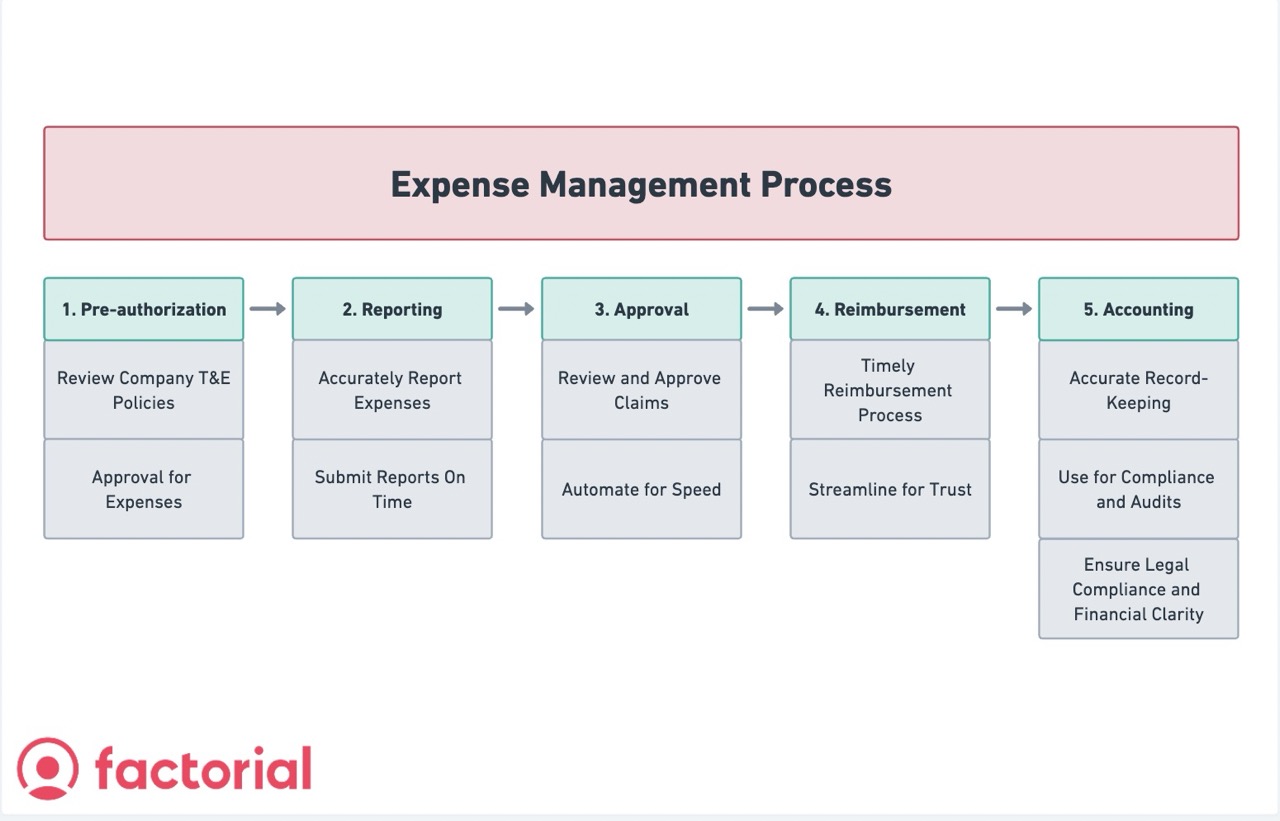Our “T&E Meaning: Travel & Expenses Guide” explains everything about managing travel & expenses.
T&E basics are explained here, with emphasis on their importance and significance to businesses. Manual tracking is tough, automation is handy, and T&E policies are a must.
Get to know how managing T&E costs not only helps businesses save time, hassle, and money, but it also helps them maximize budgets, negotiate better deals, and get more transparent about their finances. Take a look at how efficiency and cost control come together in the world of T&E management.
What Does T&E Mean?
“Travel and expense,” known as T&E in the business world, refers to employee travel and client entertainment costs. It’s a vital component in the business landscape.
In businesses, where 10% of budgets are allocated to T&E, it plays a significant role as an operating cost. Understanding T&E is essential, as it not only impacts financial management, but also influences business efficiency.
The Business Implications of Travel & Expenses (T&E)
Among businesses, T&E expense management is the second most difficult to control. This underscores the importance of effective oversight and management. Since the expenses incurred during travel and entertainment are so diverse, it’s vital to keep a tight eye on things.
T&E data can be hard to consolidate and evaluate because it’s often in disparate forms and locations. So making a comprehensive view of expenses can be hard. You can get errors and inefficiencies if you track and reconcile these expenses manually across different channels.
In order to optimize financial operations, businesses need a good T&E management system that gives them visibility and control.
Latest Statistics About Travel & Expenses
According to the following research by PRnewswire, here’s a summary of the latest statistics and insights on how companies are managing Travel & Expenses (T&E) for their employees:
Key Findings:
- Increase in Travel Spend Among SMEs: Despite economic uncertainties, over a third of surveyed companies (36%) plan to spend more than $250k annually on travel, with 16% expecting to spend over $500k.
- Corporate Travel Rebound: A 2022 poll from the Global Business Travel Association indicates a near full recovery (63%) in domestic business travel compared to 2019 levels.
- Outdated T&E Policies: More than half of the respondents (58%) have either outdated T&E policies or no T&E policies at all, leading to confusion and inefficiency in managing expenses.
Challenges in T&E Management:
- Direct Booking of Travel: 44% of respondents book travel directly, bypassing corporate booking tools, often due to a lack of knowledge about these tools.
- Inefficient Expense Management: About 32% of companies still rely on manual processes for managing expenses, leading to time-intensive tasks and dissatisfaction with current tools.
- Complexity in Expense Approval: Many find the process of reviewing and approving expenses complex, with 37% describing it as such.
Impact of Remote Work:
- The shift to remote or hybrid work environments has led to more corporate cards being issued and a decentralization of expense management processes.
- This change has highlighted the inefficiencies of legacy systems, with a lack of automation and real-time visibility. To keep up with work trends, it could be time to rethink how your company does their expense management.
Managing T&E Costs
The management of T&E costs is crucial if you’re looking to reduce expenses. T&E budgets require meticulous oversight and control, but manually tracking them is time-consuming, error-prone, and inefficient.
In order to address these issues, T&E management systems play a pivotal role. They automate expense tracking, so you can see what’s happening in real-time. By gaining this visibility, companies can figure out what areas they can cut costs in, and identify duplicate expenses and fraudulent claims. Think about creating expense report templates to standardized documentation to ensure the most accurate expense reporting.
In essence, your business can improve profitability through a well-implemented T&E system, enhancing cost-effectiveness, and ensuring expenses align with company policies.
Benefits of T&E for Cost Reduction
It’s great to know how much T&E you spend. Armed with accurate data, businesses can negotiate better prices with suppliers, enabling them to save money. It also keeps financial resources safe by preventing costly issues like duplicate invoices and fraud expense claims.
Nearly 20% of travel & expenses stray from established policies, so businesses have to identify and fix those discrepancies. Keeping expenses aligned with policies and minimizing deviations reduces unnecessary costs and helps organizations save money.
In order words, you can make more money by managing your costs!
Benefits for Business Travelers
The travel & expense management process offers benefits to employees who occasionally shoulder out-of-pocket expenses for their companies.
It’s hard to overemphasize how important prompt reimbursement is to employee satisfaction. When business travelers know their expenses will be reimbursed promptly, they feel confident making purchases on behalf of the company.
In addition to enhancing employee experience, this assurance helps employers stay on top of cost-effective and efficient business practices, creating a win-win for everyone.
Implementing a T&E Management System
In addition to enhancing expense control and efficiency, T&E management systems can give companies unparalleled insight into their spending patterns, allowing them to keep track of expenses in real time. By knowing what’s going on, businesses can make informed decisions, maximize budgets, and negotiate better deals with suppliers.
Furthermore, I think it’s important to advocate the use of tools to make company expense policies more compliant and aligned with company objectives. These policies serve as guidelines for employees, making sure expenses stay compliant and aligned with company goals. They also help prevent overspending and encourage cost-consciousness.
Aside from that, there are tons of advantages to digitizing and automating expense reporting. Businesses can reduce errors and processing times by digitizing expense reports and automating receipt reimbursement. Not only does this improve employee satisfaction, but it also streamlines the accounting process, making it more efficient and accurate.
By incorporating these advanced technologies into T&E management systems, businesses can enhance their financial agility and control costs.
Expense Categories for Reimbursement
For fiscal responsibility and policy compliance, it’s important to publish clear regulations and categories for T&E expenses. It keeps fraud at bay and helps you manage your spending better. These guidelines give employees clarity about what’s eligible and what’s not.
An expense category covers all kinds of expenses, such as flight tickets, taxi fares, and train tickets. Meals for business, like client entertainment dinners and conference dinners, are also included. Office expenses, like IT equipment and supplies for remote work, are another crucial category. Finally, lodging expenses, for things like conferences, are important.
Expenses you don’t usually get reimbursed are just as important. Examples include personal grooming activities like haircuts. Companies can avoid unnecessary costs, maintain fiscal discipline, and foster a culture of financial responsibility by defining these categories.
Expense Management Process
Five key stages make up the standard expense reimbursement process, each with its own importance:
Pre-authorization:
The first step involves reviewing the company’s T&E policies to ensure that expenses are aligned with the company’s guidelines. It’s a proactive measure to prevent unnecessary spending.
In order to ensure expenses are well-documented and within budget, employees may need approval or follow specific payment procedures.
Reporting:
Employees must accurately report expenses, including receipts or digital records, as soon as they’re incurred.
It’s important to submit reports on time to maintain financial transparency and comply with reimbursement deadlines.
Approval:
Managers or designated approvers review expense claims and accept or reject them based on company policies and budgets.
Automating this step can speed up the approval process.
Reimbursement:
A timely reimbursement process is crucial for employee satisfaction. Once approved, the reimbursement process kicks in, making sure employees get their money as soon as possible.
By streamlining this stage, you build employee trust and encourage them to spend on behalf of the company.
Accounting:
Last but not least is accurate record-keeping and accounting. Financial teams use it for tax compliance, financial statements, and audits.
It ensures the company stays compliant with legal regulations and maintains a clear financial trail.
By making each stage efficient, you’ll not only be able to control costs, but you’ll also foster transparency, policy adherence, and employee satisfaction, resulting in better T&E expense management.
Implementing a T&E Policy
It’s important for businesses to have a well-structured travel and expense policy. Besides setting clear expectations for employees, a T&E policy encourages responsible spending. It provides a framework for managing expenses, ensuring consistency, compliance, and cost control.
There’s a lot to gain from automating the expense process, including using mobile apps for request and submission. It streamlines expense reporting, so employees can submit claims from anywhere. It’s not just time-saving, it’s more accurate.
In accounting, digitizing expense reports and automating receipt reimbursements improves efficiency even more. Manual data entry is replaced with automated processes, which means fewer errors and shorter processing times. In addition to boosting employee satisfaction, this simplifies accounting procedures, ensures compliance with legal regulations, and keeps a good financial record. Using these technological advancements in T&E management enhances cost control and helps improve financial transparency and efficiency.
Save time, money, and headaches with Factorial’s expense management software

T&E: Travel & Expenses FAQ
What is t&e?
“Travel and expense,” known as T&E in the business world, refers to employee travel and client entertainment costs. It’s a vital component in the business landscape.
What is the expense management process?
The typical expense management process follows these steps: Pre-authorization, Reporting, Approval, Reimbursement, Accounting. Each company has their own workflow, consult with your team to understand your process in depth.
What are examples of T&E expenses?
In most cases, travel and entertainment expenses relate to business trips and include transportation, meals, accommodations, and entertainment, all of which are related to business travel.





